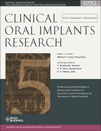Surgical protocols for ridge preservation after tooth extraction. A systematic review
Abstract
Objective
This systematic review aims to evaluate the scientific evidence on the efficacy in the surgical protocols designed for preserving the alveolar ridge after tooth extraction and to evaluate how these techniques affect the placement of dental implants and the final implant supported restoration.
Material and methods
A thorough search in MEDLINE-PubMed, Embase and the Cochrane Central Register of controlled trials (CENTRAL) was conducted up to February 2011. Randomized clinical trials and prospective cohort studies with a follow-up of at least 3 months reporting changes on both the hard and soft tissues (height and/or width) of the alveolar process (mm or %) after tooth extraction were considered for inclusion.
Results
The screening of titles and abstracts resulted in 14 publications meeting the eligibility criteria. Data from nine of these 14 studies could be grouped in the meta-analyses. Results from the meta-analyses showed a statistically significant greater ridge reduction in bone height for control groups as compared to test groups (weighted mean differences, WMD = −1.47 mm; 95% CI [−1.982, −0.953]; P < 0.001; heterogeneity: I2 = 13.1%; χ2 P-value = 0.314) and a significant greater reduction in bone width for control groups compared to the test groups (WMD = −1.830 mm; 95% CI [−2.947, −0.732]; P = 0.001; heterogeneity: I2 = 0%; χ2 P-value = 0.837). Subgroup analysis was based on the surgical protocol used for the socket preservation (flapless/flapped, barrier membrane/no membrane, primary intention healing/no primary healing) and on the measurement method utilized to evaluate morphological changes. Meta-regression analyses demonstrated a statistically significant difference favoring the flapped subgroup in terms of bone width (meta-regression; slope = 2.26; 95% IC [1.01; 3.51]; P = 0.003).
Conclusions
The potential benefit of socket preservation therapies was demonstrated resulting in significantly less vertical and horizontal contraction of the alveolar bone crest. The scientific evidence does not provide clear guidelines in regards to the type of biomaterial, or surgical procedure, although a significant positive effect of the flapped surgery was observed. There are no data available to draw conclusions on the consequences of such benefits on the long-term outcomes of implant therapy.




